|
Dang Chevaosot’s (tamarindthai) Reef Aquarium
Introduction
In 2002 we decided to open a Thai restaurant in Washington state and decided that a reef tank would be a great centerpiece for the restaurant. We had no prior experience in reefkeeping and had no idea what it would take. The initial plan was to simply create a fish-only tank with live rock, but we all know how our plans can change and expand over time.
We went out and bought a 180-gallon tank and had the tank up and running quickly but did not know enough to successfully maintain a fish-only with live rock system. Sadly, the first fish we bought died within the first few months. At this point we realized we did not know enough about reefkeeping to be successful, so we bought a ton of books and started reading while we left the tank empty, allowing it to cycle and mature.
A few months later with our new found knowledge we started adding both fish and soft coral to the tank once again. From this point on we rapidly became hooked on the hobby and within a year-and-a-half we started changing the tank to small-polyped stony corals. Our first coral was a pink Stylophora. From that point on we were buying more and more SPS and replacing the softies in the system. Eventually, the tank became a full-blown reef tank dominated with SPS with many pieces that are still my prized corals today.
In 2004 we bought what became my two largest show pieces; one was the Oregon Tort (a gift from Oregonreef.com - as seen in my system today in the center of the tank and in the next picture), and the other is what I like to call a Tamarind tort (as seen in my system today to the left of the Oregon tort and in the second picture below). The system flourished and so did our passion for the hobby, but it was inevitable that we would eventually sell the restaurant and have to move to our reef to its new (and current) location; its transfer was one of the conditions of the sale.
Building the 240 (Twice) and Moving
People say what doesn’t kill you only makes you stronger, but I think they forgot about killing one’s spirit. And that starts the story of our present day 240-gallon display we are looking at today. We bought a used 240-gallon All Glass aquarium from a local guy that had used it for freshwater. It was pre-drilled, so we felt like we were going to be all set and then began assembling our system. Of course, we did a leak test, and after we confirmed the tank looked okay, we bought a sump, pumps, sand and rock… all the things one needs to successfully build a reef tank. With most of the equipment set up we were ready for water, sand and aquascaping; we had been saving water from the tank at the restaurant to help accelerate the new tank’s cycling. Things went well; the sand was in and the rock was set up… parameters were falling into place, so we were getting ready to start moving the animals into their new home.
It was 3:00 AM when I heard the noise. BOOM! It was a fateful noise that woke me from my sleep. I wasn’t sure what had happened. I thought a bomb went off or the furnace blew up, so I rushed to the garage (where the tank was temporarily placed) and opened the door. With the first step into the garage I knew where the noise came from. There was water everywhere in the garage! My heart sank because I knew it was my tank that had exploded.
The previous night we decided to add a little more rock and another bag of sand to the tank. I’m not really sure why it happened (if it was the added weight with the extra rock and sand or if it was just its time to go), but for me, that was the end of my days enjoying the reefing hobby, or so I thought. I turned to my niece and said, “That’s it! I quit!” as I surveyed the damage. It was a real mess; the bottom blew out of the tank and all of the rock and sand dropped into the sump. There were some outlets on the floor (temporary during the setup) that were shorting out. The pumps filled with sand and seized up, and there was rock and sand everywhere (I still find little bits of sand in the garage today). It basically looked like a total loss. I opened the garage doors to the driveway and watched weeks of hard work wash down the driveway.
This is where my niece, Oum, saved the day. We were both in shock, and like I said, I was ready to throw in the towel, but Oum turned to me and said that she thought we could save everything. She stayed calm throughout the entire cleanup, saving as much of the rock and sand as she could by putting it into a large Rubbermaid tub. We made up some water and filled the tub and Oum turned to me and said, “We have everything we need except the tank and pumps, we can rebuild it.” I am so glad we started this hobby together; she was so cool under pressure and this is the reason I am able to be here today talking about our reef.
A week after our tragedy we bought a brand new 240-gallon tank (that matched the specs of our old tank) and started to rebuild the system. We let it cycle for a few weeks and started moving animals over slowly (to test the new setup). About five weeks after rebuilding the new system, we successfully moved all of the animals. Eighteen months later I can say that to this day we did not lose a single animal during the move.
Tank Information
The tank measures 72” long x 24” wide x 32” tall and has two corner overflows. The glass is 5/8” thick all the way around and is viewable from three sides. We have approximately 230 pounds of live rock in the tank, and it has about 200 pounds of sand, creating a sand bed about 2 - 2 ½” deep.
Circulation
The water flow in the tank is provided by six Tunze 6100 pumps running on a Tunze 7095 Multicontroller plus a branch adapter. We started with four of the Tunze 6100’s for the first 14 months of the tank’s life and eventually felt the need to add two more as the corals grew out and started to create areas of dead flow in the tank. The return from the sump is provided by an Iwaki 40RLT, which adds roughly 750 more gallons per hour of flow into the system.
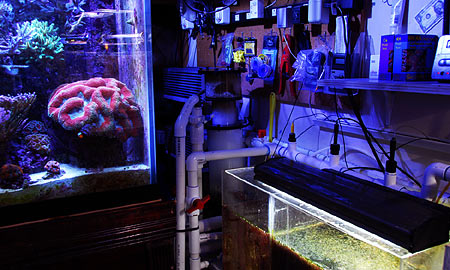 |
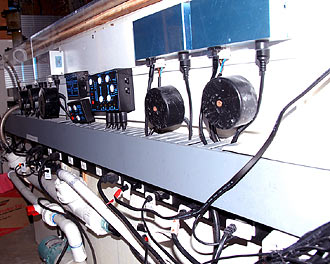 |
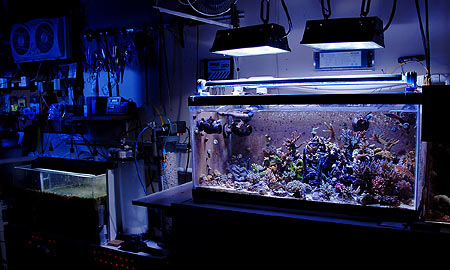 |
At this point I should note that later in the garage I built a small fragment tank from a 40-gallon breeder and have another Iwaki 40RLT that provides flow into the fragment tank from the main sump. I wanted to create a small fragment tank to help manage the corals’ growth (as they need trimming quite often now) but keeps the corals within the parameters of the tank they came out of. I also use the fragment tank to acclimate new corals to the overall system; plumbing it with the larger display has been a tremendous help in acclimating new corals as well as keeping healthy fragment alive after cutting…and keeps the display free and clear of fragments growing out.
Water Parameter Management
We are using a variety of items to maintain water parameters and key elements. Water parameters are kept in line using the Octopus 3000 to monitor ORP, temperature, pH and salinity. This helps us to know at any given time if we are having any sort of issue with the system so we can quickly react to catch and fix any potential problems.
For alkalinity, calcium and magnesium supplementation we are using a combination of Kalkwasser and a Korallin calcium reactor. Because of some of the colonies’ size in the main display I have found this to be the most effective way for us to safely maintain consistent levels in the tank around the clock.
Water Parameters
Specific gravity: 1.025
pH: 8.0 to 8.2
Calcium: 400 ppm
Alkalinity: 8 to 9 dKH
Magnesium: 1300 ppm
Phosphate: undetectable
Temperature: 77 to 78° F |
|
Filtration
The main tank’s filtration is provided by live rock and a shallow sand bed. We also have a small remote refugium that is fed by the same Iwaki that feeds the fragment tank, which uses a simple gravity overflow from both the refugium and fragment tank back into the sump. The refugium works very well at converting detritus and dissolved nutrients into live plankton. I am a firm believer that using natural filtration methods, including live rock, sand and a refugium, are not only a significant biological filtration method but tends to create a complete ecosystem that also provides nutrients for the tank.
For mechanical filtration, I am using a do-it-yourself Beckett skimmer powered by an Iwaki 75RLT. The skimmer stands one meter tall and has a six-inch reactor body and produces a hefty, sludgy skimmate. I am also using activated carbon and a do-it-yourself phosphate reactor for chemical filtration.
Lighting
The main tank is lit by three 400-watt singled-ended metal halides bulbs under Lumenarc III reflectors; the center bulb is a Radium 20K while the two on the ends are XM 20K. Before running the Lumenarc reflectors I was using three Spider reflectors, but I never felt I was getting the best lighting coverage throughout the tank, and moving to the Lumenarc reflectors quickly fixed that problem. All of the lights are spaced approximately 8” from the water’s surface. All of the metal halide lights are powered by PFO standard (M59) ballasts.
For supplemental lighting I run three 60” 140-watt URI VHO bulbs (two Super Actinics and one Actinic White) powered by Icecap 660 ballasts. We also have a 25-watt incandescent bulb to simulate moonlight at nighttime.
For the coral fragment tank we are running two 250-watt XM 20K double-ended bulbs housed in ReefOptix III pendants which are fired by a PFO dual HQI ballast. There are also two T5 Super Blue+ and Actinic+ for supplemental lighting over the reef tank. The refugium is on a reverse daylight schedule using two 24” 65-watt power compact fluorescent bulbs.
These lights are controlled by an Octopus 3000 using every option available. The tank’s daytime lighting sequence starts with the set of three VHO bulbs coming on first, followed by the center halide bulb thirty minutes later. The two metal halides on either side of the center bulb fire together another half hour later with the end of the daylight cycle powering off in reverse order, ending with the VHO bulbs tuning off.
Photoperiod
8:30 a.m.: moonlight on
9:30 a.m.: VHO actinic on
09:45 a.m.: moonlight off
10:00 a.m.: center 400-watt halide on
10:30 a.m.: both side 400-watt halides on
5:00 p.m.: center 400-watt halide off
5:30 p.m.: both side 400-watt halides off
06:30 p.m.: moonlight on
07:00 p.m.: VHO actinic off
09:30 p.m.: moonlight off
Temperature Control
Because heat is a major concern for small-polyped stony corals, we use a 1 HP chiller to help maintain a consistent temperature. The tank’s water temperature is monitored and controlled by the Octopus 3000 and is set to maintain the display between 77-78° F year round. As the corals have continued to grow, managing parameters such as the water temperature becomes more of an issue. Adding the chiller has given me a peace of mind that this sensitive parameter is being maintained at all times
Inhabitants
My reef is dominated by small-polyped stony corals, along with a few large-polyped stony corals, clams and fish. Many of the corals were grown from small fragments. I now have a few decent sized pieces mixed with some medium and large sized colonies, and a few fairly small corals that have been added within the last few months. Here is a list of some of the corals and fish:
Fish:
Pair of True Percula Clownfish
Magnificent Foxface Rabbitfish
Goldspotted Rabbitfish
Yellow Tang
Kole Tang
Green Mandarin Dragonet
Chevron Tang
Sunburst Anthias
Dragon Pipefish
Banded Pipefish
Randall’s Prawn Goby |
|
Corals:
Acropora sp “Blue monster Echinata”
Acropora sp. “Tub's Mystic blue”
Acropora sp. “Purple staghorn”
Acropora sp. “Loisatae staghorn”
Acropora sp. “Green w/blue tips”
Acropora sp. “Blue staghorn”
Acropora sp. “Purple Monster”
Acropora sp. “Rainbow”
Acropora sp. “Incredible Hulk”
Acropora sp. “Mike Paletta Pink and Green”
Acropora sp. “Pink Lemonade”
Acropora sp. “Tubs Pink Jade”
Acropora sp. “Blue Turaki”
Acropora sp. “Bali Tricolor”
Acropora sp. “O.R.A. chips w/blue tips”
Acropora lokani – blue
Acropora nana
Acropora loripes
Acropora gomezi
Acropora hoeksemai
Acropora tenuis
Acropora plana
Acropora granulosa
Acropora caroliniana
Acropora yongei “Green Slimer”
Acropora deswalii “Purple-tipped
Acropora lovelli “Mike Paletta Turquoise”
Acropora millepora – three different color varieties
Acropora tortuosa “Becker blue Tort”
Acropora tortuosa “Cali Tort” |
Acropora tortuosa “Oregon Tort”
Acropora tortuosa “deep purple tort”
Acropora tortuosa “Miyagi tort”
Montipora sp. “Sunset Monti”
Montipora sp. “Tyree fire engine”
Montipora venosa “Pink Sand dollar”
Montipora sp. “Purple Haze Monti”
Montipora sp. “Rainbow Monti”
Montipora sp. Superman Monti”
Montipora sp. “Strawberry Patch Monti”
Montipora undata “Idaho Grape”
Montipora setosa
Montipora digitata “ROAB green w/orange polyps”
Acantastrea sp. - various colonies
Blastomussa welsi
Blastomussa merletti
Cyphastrea japonica
Cyphastrea ocellina
Cyphastrea decadis “Red Star”
Favia spp.
Lobophyllia hataii “lobed brain”
Micromussa spp.
Montastrea “Dragon Eye”
Pocillopora sp.
Pavona sp.
Turbinaria sp.
Stylophora sp. “Rainbow”
Seriatopora sp.
Ricordea florida
Ricordea yuma
|
|
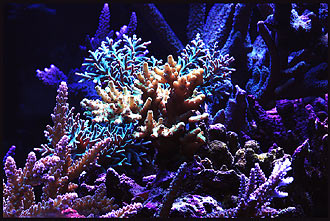 |
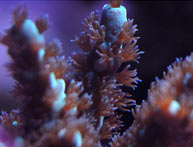 |
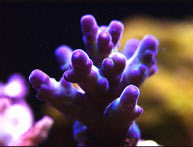 |
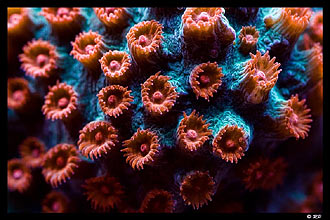 |
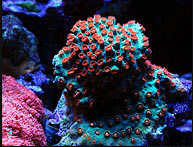 |
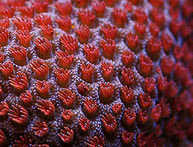 |
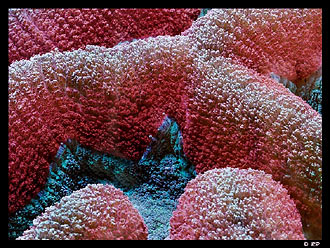 |
Invertebrates:
350 Blue leg hermit crabs
100 Red leg hermit crabs
350 Cerith snails
75 Turbo snails
Gold Teardrop Tridacna maxima clam
Blue Tridacna maxima clam
Blue Tridacna crocea clam
Tridacna derasa clam |
|
Feeding
The tank is fed daily with Ocean Nutrition’s Formula 1, Formula 2 and a mix of Mysis. Twice each week it’s fed a mix of rotifers, brine shrimp, Golden Pearls and Cyclop-Eeze®. We are feeding after the lights go off using the manual food timer on the Tunze controller to slow the pumps during feeding time.
Routine Maintenance
Water changes of approximately twenty-percent are performed every week. The salt is mixed with RO water using Instant Ocean, aerated for one day and then added to the tank on the following day. The skimmer collection cup is cleaned as needed, which usually is about once per week. Weekly, I also check the proper operation of the calcium reactor, CO2 tank, all the pumps and the controller. Bi-weekly water tests are conducted with Salifert calcium and alkalinity test kits. With the tank now mature and stable other tests are performed only on rare occasions.
End Notes & Thanks
Over the last five years I have found that to be successful in this hobby, reefkeepers must have patience. When it came to stocking the system, I have never been in a hurry to fill the tank. I also think a successful system is the result of the hobbyist’s ability to recognize what may not be right and taking appropriate steps to fix it.
First and foremost I want to thank my niece, Oum. She’s the primary maintainer of the tank today, helping with a lot of the in-tank work. As I’ve said before, we would not be here today without her assistance. There are so many other people I want to thank, too. This hobby has so many great rewards, but I have to say one of my favorites is all the great and friendly people out there that enjoy this difficult yet rewarding hobby. I don’t need to name any of my close friends and reefkeeping buddies, but they know who they are, and they know that I appreciate them! (Well, special thanks to some friends that made this all possible: Cari, Cesar, Jesse, Todd and Rick). Finally, I would like to thank Reef Central for giving me the opportunity to share my passion for reefkeeping and choosing my system as Tank of the Month.
Profuse appreciation goes out to Rick Parchen for all the beautiful pictures.
Feel free to comment
or ask questions about my tank in the Tank of the Month thread on Reef Central.
If you'd like
to nominate a tank for Tank of the Month, click here or use the button to the right. |
 |
|

